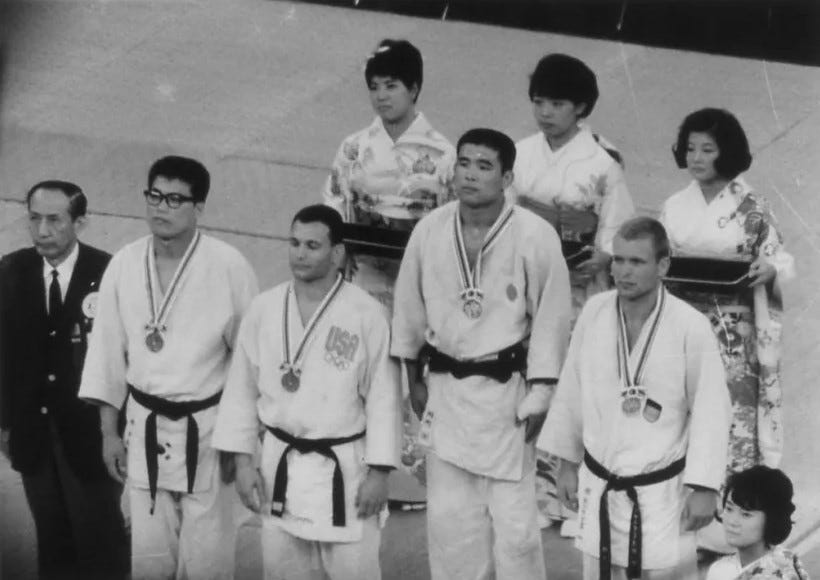Tokyo 1964, Day 2 (-80kg): Isao Okano (JPN)
On Day 2, the top favorite was again another Japanese player. This time, it was the flamboyant youngster Isao Okano from Chuo University. Okano was a very versatile player who could throw to both the right and the left, and was very capable in groundwork. He was also known for his indomitable fighting spirit. In many ways, Okano was a complete judo player.
There was little doubt that he would emerge the gold medalist, especially since the Soviet Union did not enter any players in this division. Okano had actually lost to a Russian player named Boris Mishchenko in a pre-Olympic competition between the Soviet Union and Japan in 1963, in Kyoto. Right at the start of the match, Mishchenko took Okano to the ground and snapped on an armlock that had Okano tapping furiously. The whole match lasted less than 20 seconds. It was reported that some in the crowd felt that Okano should have let his arm be broken than submit to his Russian opponent.
Although juji-gatame was a judo technique, in practice, it was rarely seen in Japanese judo circles, where strangles and hold-downs were more common. Japanese players of that era encountered armlocks for the first time when they fought the Russians.
With no Russians competing in his weight class, Okano had one less thing to worry about in his quest for Olympic gold. As expected, Okano blitzed his way through to the quarterfinal, easily defeating Fernando Costa Matos (POR) and Lugo Jorge (VEN). His quarterfinal opponent was the capable Frenchman Lionel Grossain but he too could not contain Okano, who defeated him in a very flashy manner.
During a newaza exchange, Okano managed to pull Grossain’s lapel across his neck. But instead of doing a standard lapel choke, Okano did a sacrifice movement whereby he allowed himself to be held in a kami-shiho-gatame while he was applying the choke. His bet was that Grossain would pass out before the 30 second count was over.
Okano didn’t need 30 seconds. Grossain became limp after just a few seconds. It happened so fast the referee didn’t even notice it and only stopped the match after some Japanese coaches pointed out that the Frenchman was not moving at all. After ippon was called, Okano amused the crowd by trying to revive Grossain using a traditional Japanese resuscitation technique called katsu.
That win took Okano into the semifinal where he would face South Korean’s Kim Eui-tee. Theirs was an all-out rumble with both players launching big attacks. At one point, the Korean threw Okano with a powerful tani-otoshi that had the Japanese flat on his back. But since the landing happened outside the contest area, no score was given. In the end, it was Okano who came closest to scoring with a nidan-kosoto-gari that knocked the Korean down to his side. It wasn’t enough to merit a waza-ari but it gave Okano enough of a kinsa advantage to win the match.
In the final, Okano wasted no time in attacking his opponent Wolfgang Hoffman of West Germany. In the opening seconds, he did a powerful ippon-seoi-nage to the left that had the German spinning through the air to avoid a score. This clearly rattled Hoffman, who decided to switch to newaza mode. He came in with a sacrifice kosoto that took both men to the ground. With Okano in between his legs, Hoffman attempted to do an armlock. Perhaps extra wary of armlocks after his humiliating defeat to Mishchenko in Kyoto, Okano simply moved past Hoffman’s legs and clamped on a yoko-shiho-gatame. The whole match was over in about a minute and a half.
(I owe a debt of gratitude to Nicolas Soames, whose account of the Olympics was great research material for this series.)




